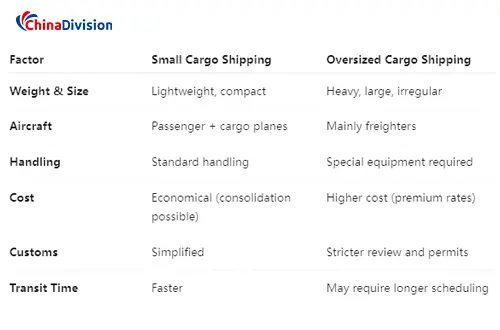Key Differences Between Small and Oversized Cargo Air Freight
Air freight, with its speed and reliability, has become a crucial link connecting global markets. But why is air freight so simple and convenient for some small packages, while the pricing and process for larger equipment or specialized cargo is so much more complicated?
Table of Contents
This article will delve into the key differences between small and oversized cargo air freight, addressing common pain points and answering your most pressing questions.

How do you identify your cargo type?
Small cargo
Generally refers to standard-sized shipments that are lightweight (generally less than 45kg) and small enough to be easily integrated with other cargo without requiring special handling.
For example:
Electronic components
Clothing and accessories
Small mechanical parts
Sample products for testing
Key features of small cargo shipping:
Faster processing
Small packages are easier to handle, sort, and load, resulting in shorter shipping times.
Lower costs
Small cargo is often more economical to ship by air because it takes up less space and requires minimal special handling.
Less documentation
A standard shipping label, commercial invoice, and packing list are usually sufficient.
Flexible delivery options
Many carriers offer door-to-door, airport-to-airport, or courier services for small shipments.
Advantages of small cargo air shipping:
Lower per-unit freight rates (due to consolidation)
Shorter shipping time
Simplified customs clearance
Flexible scheduling
Oversized cargo (Oversized Cargo / Large Cargo)
Oversized cargo (ULD) refers to a single piece of cargo that exceeds the airline's standard container (ULD, such as a pallet or container) size limits. Common criteria include: a single piece weighing more than 150 kg or a length of 120 cm (or 158 cm, depending on the airline) or greater on any side. Examples include large machinery and equipment, automotive parts, exhibition materials, and large models.
Examples include:
Industrial machinery
Vehicles (cars, motorcycles)
Oversized equipment (generators, medical equipment)
Furniture and large retail displays
Key characteristics of oversized cargo shipping:
Special handling requirements
Oversized cargo may require disassembly, reinforced packaging, or custom crating.
Higher costs
Oversized cargo is more expensive to ship by air due to the additional space, weight, and handling fees.
Documentary complexity
Additional permits are required, such as oversized cargo declarations and special handling authorizations.
Limited carrier options
Not all airlines accept oversized cargo, so scheduling and routing can be challenging.
Small Cargo Shipping Process
Receiving and Consolidation
We receive breakbulk cargo from multiple customers and professionally sort, measure, label, and consolidate into standard container units (ULDs) at our warehouse to maximize space utilization and reduce your unit costs.
Booking and Operations
Highly standardized processes. Booking general cargo capacity with airlines is simple and offers a wide range of flight options.
Customs Clearance and Security Inspection
Bulk customs clearance is used for a streamlined process. Security inspections are also conducted for standard items, ensuring rapid customs clearance.
Loading and Transportation
The consolidated ULDs are loaded into the cargo hold by airport ground staff according to standard procedures and flown alongside other cargo.
Customs Clearance and Delivery at the Destination Port
Upon arrival at the destination port, bulk customs clearance is carried out, followed by the "last mile" small cargo delivery by Chinadivision's partners or its own fleet.
Oversized Cargo Transportation Process
Professional Consultation and Solution Design
This is the most critical step. You will need to provide detailed cargo information (length, width, height, weight, center of gravity, packaging material, and whether it is non-removable) in advance. Our team of experts will assess feasibility, plan the optimal route, select the appropriate aircraft (such as a wide-body freighter like the Boeing 747 or Antonov AN-124), and develop a detailed loading and unloading and securing plan.
Special Booking and Approval
You must apply for special cargo space from the airline and provide relevant documentation to obtain transportation approval. Airlines need to assess the cargo's impact on flight load balance and cabin dimensions, a process that takes longer.
Professional Packaging and Reinforcement
Cargo must be packaged in sturdy wooden boxes or frames (compliant with ISPM-15 standards), with internal padding such as foam and brackets to prevent movement. The center of gravity and lifting points must be clearly marked on the exterior.
Specialized Handling and Operation
Conventional conveyors and trailers cannot be used. Specialized equipment such as lift trucks and cranes is required for loading and unloading, and operators must be professionally trained.
Dedicated Installation and Securing
Cargo is typically placed on the main cargo floor of a cargo aircraft and securely fastened to the aircraft structure using specialized securing devices (such as safety belts and bracket nets) to prevent movement during flight and ensure absolute safety.
Specialized Customs Clearance and Destination Services
Due to its unique nature and high value, customs clearance requires more detailed documentation. Destination pickup also requires pre-arranged heavy-duty trucks and lifting equipment, making conventional bulk cargo delivery impossible.
Besides freight, what other "hidden" costs should be considered when transporting oversized cargo?
In addition to the basic air freight rate, you also need to budget for:
Special handling fees: Airlines charge for special services for oversized or overweight shipments.
Packaging fees: Customized wooden crates/frames.
Equipment usage fees: Rental fees for platform lifts and cranes.
Escort/guide fees: Shipments exceeding width or length may require special permits or even police escorts for land transport in the destination country, which can be costly.
Insurance: Given the high value and unique risks of shipments, it is recommended to purchase additional cargo insurance.
Frequently Asked Questions about Small and Oversized Shipments
How do I determine if my shipment is oversized?
Airlines typically define oversized shipments based on dimensional weight (length × width × height divided by 5000) or actual weight. If your shipment exceeds 100 kilograms or 3 cubic meters, it is likely oversized.
What are the average shipping times for small and oversized shipments?
Small shipments typically take 3-7 business days to ship by air, while oversized shipments may take 7-14 days due to additional handling and routing complexity.
What documents are required for air freight of small and oversized cargo?
Both modes of transport require supporting documents such as an air waybill (AWB), commercial invoice, packing list, and certificate of origin. Oversized cargo may also require special permits or customs documentation, depending on the destination country.
Can oversized cargo be shipped via regular air freight?
No. Oversized cargo typically exceeds the size and weight limits of standard airlines and requires booking a dedicated cargo aircraft designed for heavy or bulky items.
How can I reduce the cost of shipping oversized cargo?
Optimize packaging to minimize dimensional weight.
Consolidate multiple shipments to reduce unit costs.
For less urgent oversized cargo, use sea/air freight (a hybrid option).
Does Chinadivision handle both small and oversized cargo?
Of course! We provide end-to-end air freight solutions for both small packages and oversized cargo, including customs clearance, insurance, and real-time tracking.
What is the difference between bulk cargo shipping and oversized cargo shipping?
Bulk cargo generally refers to goods shipped in bulk, such as grain and fertilizer, and is often transported by sea. Oversized cargo, on the other hand, refers to cargo that exceeds the size limit and requires special air freight arrangements. Chinadivision can customize air or sea freight solutions based on the type of cargo.
How does Chinadivision assist with small and oversized cargo air freight?
Chinadivision specializes in providing small and oversized cargo air freight services to B2B companies and e-commerce sellers. Our advantages include:
Flexible solutions
From small to bulk cargo air freight, tailored to your business needs
Cost optimization
Smart consolidation and route planning to reduce costs
Expert handling
Special arrangements for oversized cargo air freight
End-to-end service
From pickup and packaging in China to overseas customs clearance and delivery
The choice between small and oversized cargo shipping depends on the size, weight, urgency, and budget of your shipment. Small cargo shipping is faster and cheaper, while oversized cargo shipping requires special planning and is more expensive.
Whether you're shipping small e-commerce packages or oversized industrial equipment, Chinadivision offers customized logistics solutions to meet your needs. Our expertise in customs compliance, carrier partnerships, and real-time tracking ensures smooth and cost-effective global shipments.
By understanding the differences between small and oversized shipments, you can make informed decisions that save time, reduce costs, and improve customer satisfaction. Let Chinadivision handle the logistics for you, allowing you to focus on growing your business!





